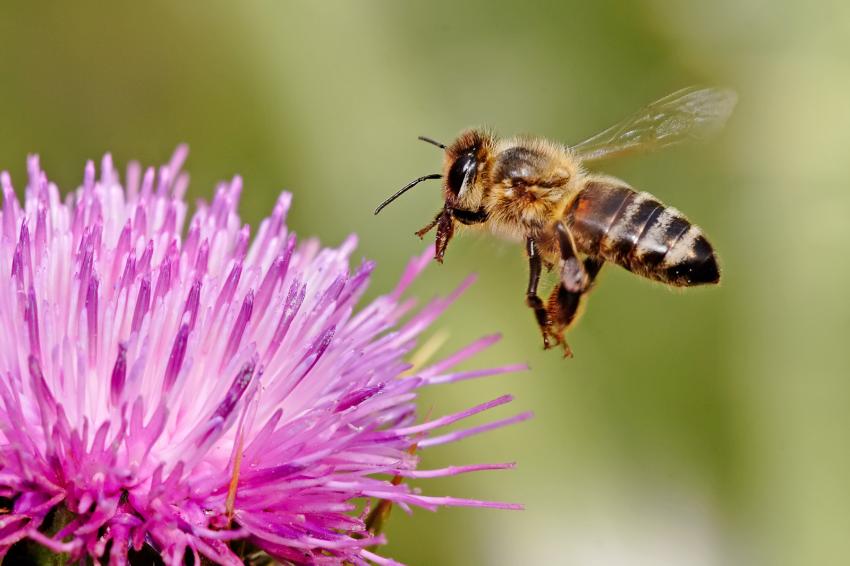11 Dec 2024

Tired Earth
By The Editorial Board

Whether you love them or loathe them, we all depend on bugs. Insects help to pollinate three-quarters of the world's crop varieties, making them a treasured resource.
But we're making the lives of insects tough—and not just by swatting them away with a newspaper. Insect populations worldwide are in sharp decline as they battle against climate change, habitat loss and pesticides.
Now, we can add air pollution to the list of threats. Our research from 2022 revealed that when exposed to two common air pollutants at concentrations within EU air quality limits, the visits of pollinating insects to flowers plummeted by as much as 90%.
Over a span of two years, we artificially elevated the levels of either ozone or diesel exhaust fumes around plots of flowering black mustard plants, all within fields of non-flowering wheat. We carefully monitored and controlled the release of pollutants using rings constructed around each plot.
This method allowed us to monitor the number of pollinating insects visiting the flowers in polluted plots and draw comparisons with plots devoid of pollutants.
We were surprised by what we found. In the rings where we released ozone or diesel exhaust fumes, the number of pollinating insects decreased by 70% and overall pollination success rates decreased by up to 31%.
It wasn't just bees and butterflies that were affected. Ground-dwelling insects suffered too, with exposure to these pollutants causing their numbers to decrease by as much as 36%.
Why air pollution makes life so hard
Many insects rely on their sense of smell to locate flowers. When they feed on nectar, they quickly connect the flower's scent with its sugary reward. Consequently, when they come across the same scent later on, they track its trail in pursuit of another tasty treat.
Thus, flowers serve a dual purpose. They are not just pretty to look at but also function as beacons that release a specific blend of fragrant chemicals designed to attract pollinators.
But these signals are under threat. Air pollutants like ozone are highly reactive and can degrade the signals by destroying the chemicals that make up a flower's scent.
In our more recent research, we simulated a floral scent in a 20-meter long wind tunnel and then mapped out how the levels of each of the chemicals that made up the scent changed in response to increasing ozone pollution. We found that ozone quickly ate away at the edges of the plume, reducing both its width and length.
Essentially, the chemical signal could travel only a shorter distance, which limited the number of insects it could reach.
Adding ozone also changes the smell of each of the chemicals that make up a flower's scent. By observing these changes in a wind tunnel, we could measure the speed at which these chemical changes occur.
Some chemicals degraded within seconds, whereas others were not affected at all. How far away you are from the scent's source appears to change how the scent smells.
Pavlov's Bees
To understand how changes to the floral scent might affect pollinators, we taught honeybees to recognize the same floral scent that we released into the wind tunnel. Much like Pavlov's dogs drooling at the sound of a dinner bell, bees stick out their proboscis (tube-like tongue) when they sniff an odor they have learned to associate with a sugary reward. This allowed us to see how many bees could still recognize the floral scent once it had been exposed to ozone pollution.
We first tested the honeybees with scent blends replicating those observed at the plume center when ozone levels were elevated. At a distance of six meters from the flower, 52% of bees recognized the scent. This fell to only 38% at a distance of 12 meters.
We then tested the response of honeybees to the more degraded plume edges. Only 32% of the bees responded at six meters, falling to just 10% at 12 meters.
These results help to explain the significant decline in the number and diversity of insect visits and pollination rates observed in our field trials. Put simply, ozone pollution limits the reach of chemical signals and changes their meaning, leaving insects confused.
But this is unlikely to be the full story. Although we replicated the effects of ozone pollution on floral scents, we never exposed the bees directly to ozone. Separate research carried out in France suggests that direct exposure to ozone might also impair the ability of bees to detect floral scents.
The full extent to which air pollution is impacting the insects we all depend on is only just beginning to be revealed. So, the next time you lift your newspaper to swat a bug, take a second and ask yourself—don't they have it tough enough already?
Source : phys.org
Comment
Wild Captured
2024/30/11
Who produced the first plastic? And in what year?